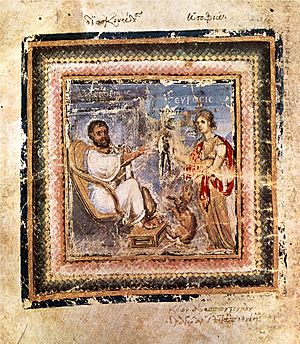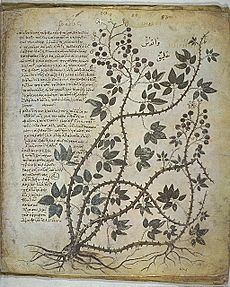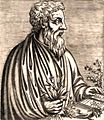Pedanius Dioscorides facts for kids
Quick facts for kids
Pedanius Dioscorides
|
|
|---|---|

Dioscorides receives a mandrake root, an illumination from the 6th century (c. 512) Greek Juliana Anicia Codex
|
|
| Born | c. 40 AD Anazarbus, Cilicia, Asia Minor
|
| Died | c. 90 AD |
| Other names | Dioscurides |
| Occupation | Army physician, pharmacologist, botanist |
| Known for | De Materia Medica |
Pedanius Dioscorides (Greek: Πεδάνιος Διοσκουρίδης; c. 40–90 AD) was an important Greek physician, botanist, and writer. He is often called "the father of pharmacognosy" because of his work with medicines. He wrote a famous five-volume book called De materia medica (which means "On Medical Material"). This book was like an encyclopedia about herbal medicine and other healing substances. People used it for over 1,500 years! For a very long time, Dioscorides was seen as the most important writer about plants and plant-based medicines.
Life of Dioscorides
Dioscorides was born in a place called Anazarbus in Cilicia, which is now part of Asia Minor. He probably studied medicine in a nearby city called Tarsus. This school was known for its focus on medicines.
Dioscorides wrote that he lived a "soldier's life." This suggests he might have traveled a lot with the army. However, his book mainly talks about plants found in the eastern Mediterranean, where Greek was spoken. This means he likely traveled in that area, perhaps as an army doctor or a civilian. His Roman name, Pedanius, suggests that a Roman noble helped him become a Roman citizen.
De materia medica: A Book of Medicines

Between 50 and 70 AD, Dioscorides wrote his five-volume book in Greek. It was called Περὶ ὕλης ἰατρικῆς, but it's better known by its Latin name, De materia medica. This book was a very early version of what we now call a pharmacopeia. A pharmacopeia is an official book that lists medicines and how to use them.
Unlike many old books, De materia medica was never lost. People kept reading and copying it for centuries. In fact, it was more important than even the writings of Hippocrates for a long time in Western medicine.
During the Middle Ages, the book was copied in Greek, Latin, and Arabic. Over time, people added their own notes and small updates from Arabic and Indian sources. Many copies of De materia medica were beautifully illustrated. The most famous one is the Vienna Dioscurides, made around 512 AD.
De materia medica is a key source of information about the medicines used by ancient Greeks, Romans, and other cultures. It also recorded the names of some plants in languages like Dacian, Thracian, Roman, ancient Egyptian, and North African languages. These names would have been lost forever without his book.
The book describes about 600 plants. Sometimes, the descriptions are a bit hard to understand, so people have tried to figure out exactly which plants he was talking about for centuries.
Dioscorides' book was the main guide for European medicine until the 1800s. This shows how useful and accurate his work was. It was based on trying things out and seeing what worked.
The plant group Dioscorea, which includes the yam, was named after Dioscorides by the famous scientist Carl Linnaeus. A butterfly, the Bush hopper (Ampittia dioscorides), is also named after him.
Gallery
-
Cumin and dill from an Arabic book of simples (ca. 1334) after Dioscorides (British Museum)
-
Byzantine De materia medica, 15th century
See also
 In Spanish: Dioscórides para niños
In Spanish: Dioscórides para niños
- Materia medica
- Dioscorea








